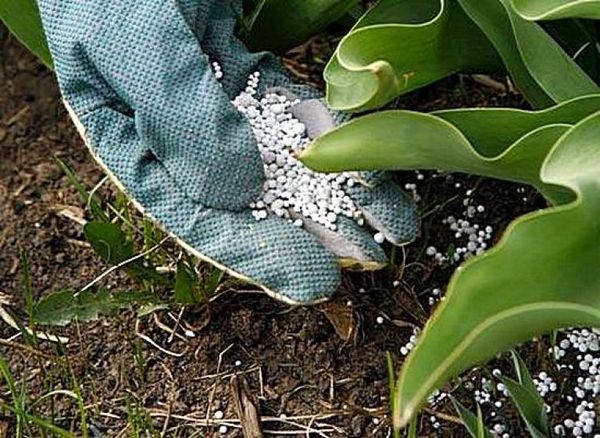The basic resource for the normal functioning of both representatives of the plant world, and various living organisms, is nitrogen. It is part of the so-called "life-four", which also includes oxygen, hydrogen and carbon. These elements constitute the most important part of the tissue composition of most living micro and macroorganisms, and they are contained in special nitrogen fertilizers.
Table of contents
What is nitrogen for plants
Optimal harvest using only natural resources of the soil is almost impossible. Therefore, it is necessary restocking nutritional ingredients. What will these substances be like - the garden owners think over in their own way, and the choice is influenced by the types of crops, the time of year, and the experience of previous feedings.
Chlorophyll, for example, has a nitrogenous component, which is important for the absorption of solar energy, alkaloids, lipids and many other compositions that are vital for vegetation.
In the springtime, nitrogen gives saturation of young stalks in the active stage of growth, gradually moving to new buds, leaves and stems.
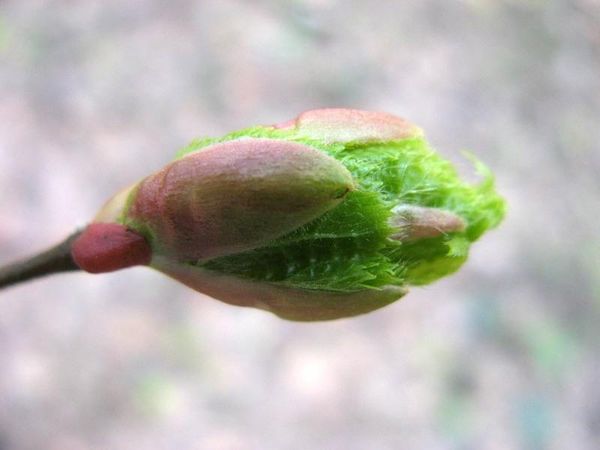
After pollination of plants, nitrogenous substances reach the reproductive organs, where they settle in protein form. Protein gets great value in fruits, it is observed more active growth, increases the quantitative and qualitative component of the crop.
How to understand that the plant lacks nitrogen fertilizers
A clear sign of nitrogen deficiency is the color of the foliage - jaundicedA pale yellow version is also possible. The process of yellowing is initiated from the edge of the leaves and spreads to the center. The lamina becomes thinner and softer.
The first yellow leaves below. In extreme cases, the foliage can dry out completely and fall off: all the nutrients go to maintain the upper shoots or fruit.
There are two reasons for the lack of nitrogen in this case:
- The plant did not receive proper feeding;
- The ground is strong sourthat makes it difficult to absorb nitrogen.
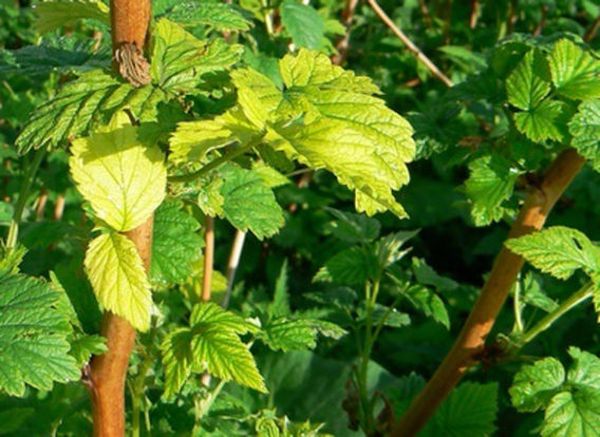
Anyway, it is necessary to update or replace the primer, and follow the time and rules of feeding.
About the classification of fillers
The described fertilizers are obtained from ammonia synthetic properties and are divided into several types characterized by their features:
- Ammonia, with the described substance in the form of ammonia in combination with mineral acid. These include ammonium chloride, bicarbonate and ammonium sulfate, ammonium fertilizers of liquid type.
- Nitratethat possess salts of nitric acid.Sodium nitrate, potassium nitrate, calcium nitrate are considered to be this variant.
- Amidecontaining the substance in the amide form. This type implies urea, calcium cyanide, urea formaldehyde fertilizers.
There are types of fertilizers where the nitrogen component comes in several forms. This is an ammonium nitrate species, with calcium-ammonium and ammonium nitrate. The latter can act both in ammonium and in nitrate form.
The classification and combination of additives with nitrogen is related to soil type, climatic characteristics and differences in the care of that or another plant.
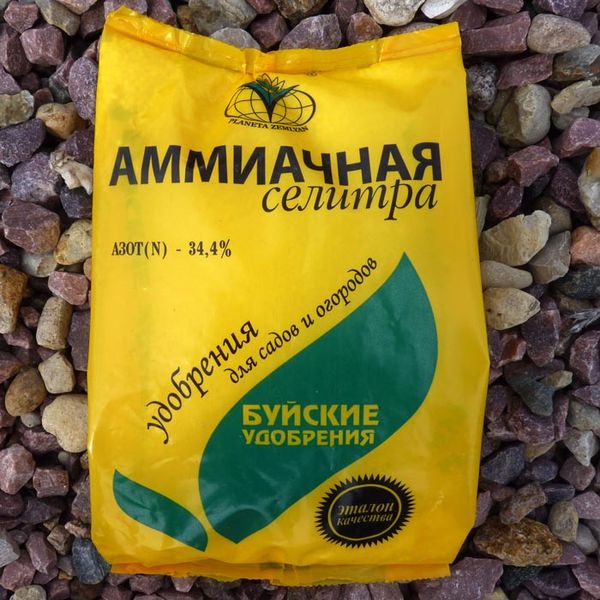
How much is the correct fertilizer
- On average, as a base for fertilizing potatoes, vegetables, fruit and berry and flower crops is considered from 600 to 900 g. nitrogen per 100 square meters. meters
- If we are talking about top dressing, then for vegetable crops and potatoes make about 200 grams on the same 100 square meters, and for berry and fruit options - 200-300 grams.
- For the appropriate liquid consistency the calculation goes from 15 to 30 g. on 10 l. water.
- When planning the use of a substance outside the root, you need 25-50 g. on 10 liters.Fertilizer is distributed on 100-200 m2.
For a larger guideline, we present a table with nitrogen content for any of the fillers with their name.
| Fertilizer | Item capacity |
| Ammonia | |
| Anhydrous ammonia | 82,3% |
| Ammonia water | 20,5% |
| Ammonium sulfate | 20,5-21,0% |
| Ammonium chloride | 24-25% |
| Nitrate | |
| Sodium Nitrate | 16,4% |
| Calcium Nitrate | 13,5-15,5% |
| Ammonium nitrate | |
| Ammonium nitrate | 34-35% |
| Calcium ammonium nitrate | 20,5% |
| Ammonia based on ammonium nitrate | 34,4-41,0% |
| Ammonia based on calcium nitrate | 30,5-31,6% |
| Ammonium sulfonitrate | 25,5-26,5% |
| Amide | |
| Calcium cyanamide | 18-21% |
| Urea | 42,0-46,2% |
| Urea-formaldehyde and methylene-urea (slow action) | 38-42% |
| Urea Based Ammonia | 37-40% |
For which crops is it appropriate to use nitrogen
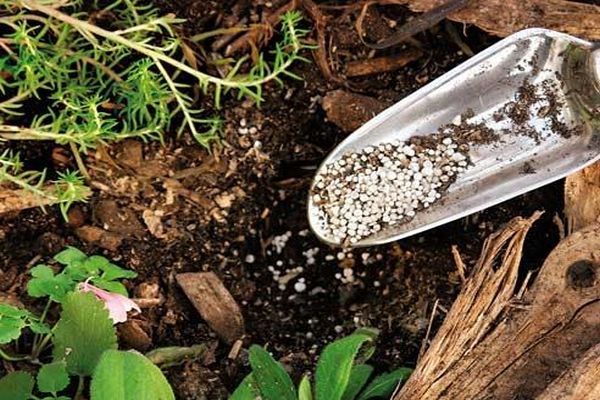
In fact, this component is important for any plant, including when grown at home, the difference is only in its quantity. In this regard, cultures are divided into:
- Plants that fertilize in the spring before planting in the ground. Calculation of ammonium nitrate - 25-30 g. on 1 square meter of the area of crops.These include potatoes, eggplant, pumpkin, cabbage like vegetables; Cherries, raspberries, plums, blackberries like fruit and berry crops, roses, peonies, phloxes, carnations, zinnias and others like floral varieties.
- Cultures that need less nitrogen fertilization 20 g. per square meter. These are vegetables such as tomatoes, cucumbers, corn, beets, garlic; fruit varieties - apples, gooseberries, currants, all annual flowers and delphinium.
- The third group requires moderate element filling. This includes radishes, onions, early potatoes, pears, primroses, daisies.
- Plants that need a minimum of nitrogen - aromatic cultures, peas and beans, as well as flowers such as heather, portulaca, Japanese azalea, rhododendron.
On the negative impact of a surplus of nitrogenous supplements
Both nitrogen deficiency and excessive substance intake have a negative effect. From such an excess begins too active development of the aerial mass cultures. The leaves expand, become larger interstices.
The leaves are splendid and soft, and the flowering is quick and scanty, sometimes even absent. Therefore, the ovary is formed poorly, affecting the absence of future fruits and berries.
All crops need nitrogen. It is important to determine its dosage and make all the rules, including the characteristics of each plant.
